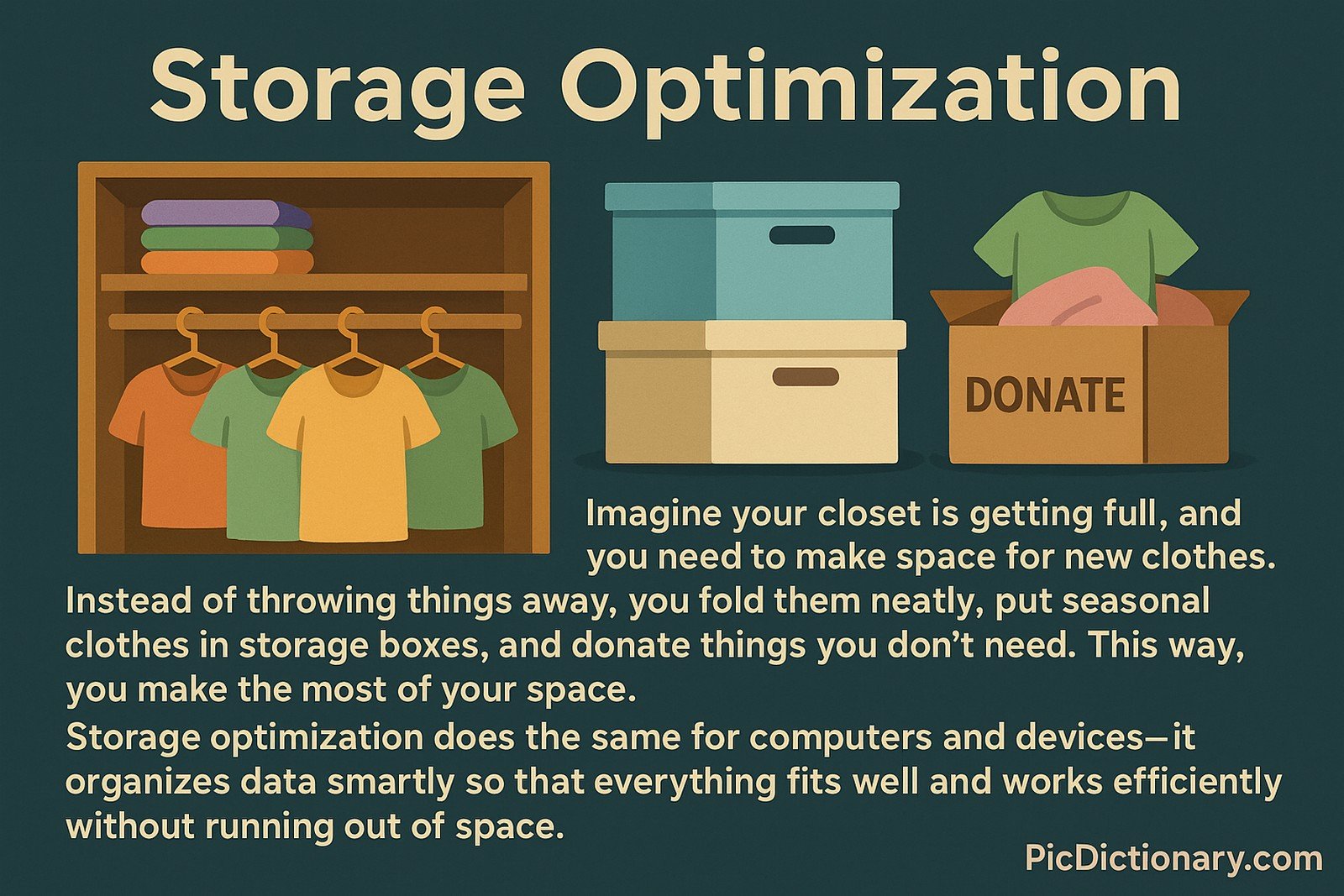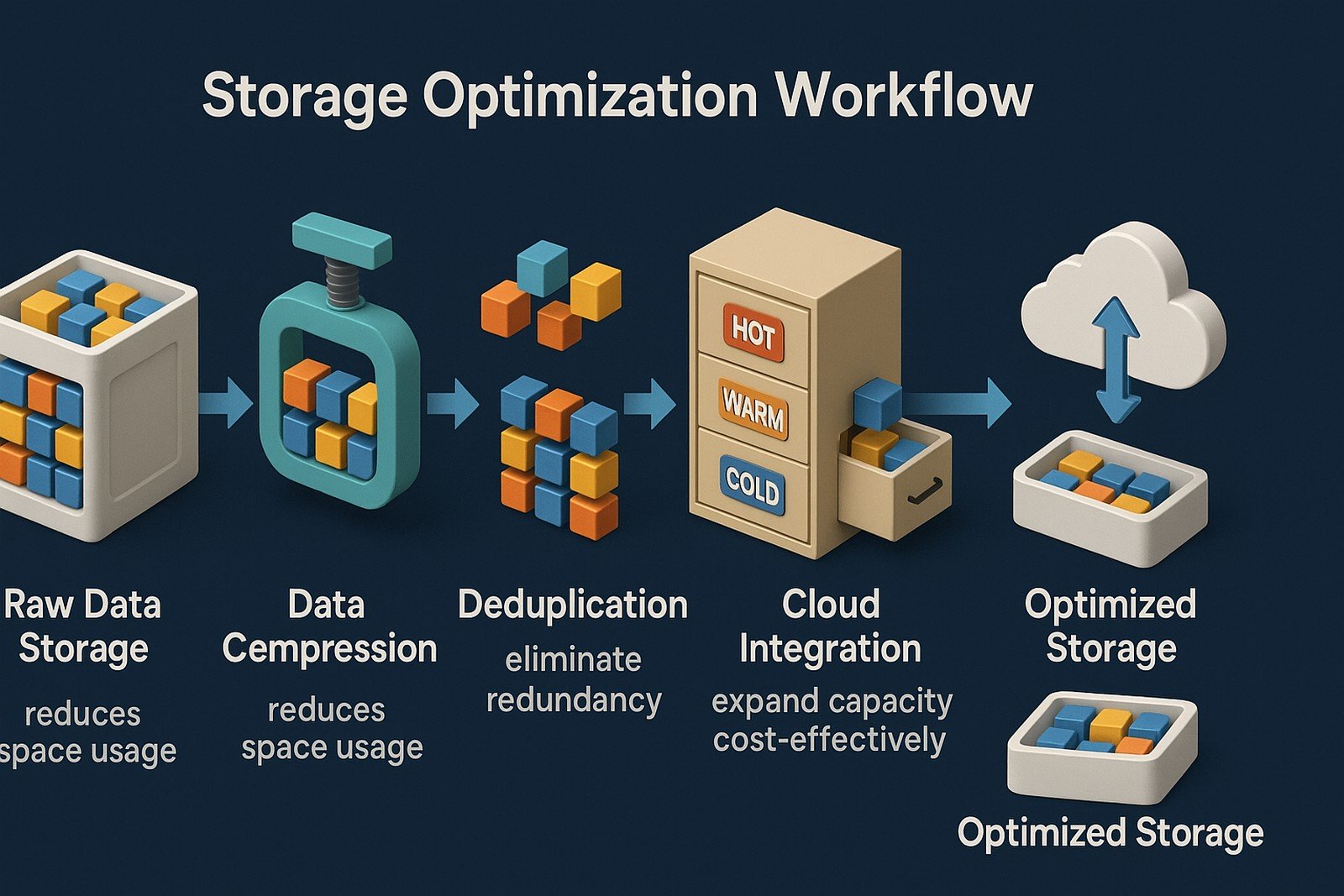Storage Optimization
 (Representational Image | Source: Dall-E)
(Representational Image | Source: Dall-E)
Quick Navigation:
- Storage Optimization Definition
- Storage Optimization Explained Easy
- Storage Optimization Origin
- Storage Optimization Etymology
- Storage Optimization Usage Trends
- Storage Optimization Usage
- Storage Optimization Examples in Context
- Storage Optimization FAQ
- Storage Optimization Related Words
Storage Optimization Definition
Storage optimization refers to the process of managing, organizing, and improving the efficiency of data storage to maximize capacity and performance while minimizing costs. This involves techniques like data compression, deduplication, tiered storage, and cloud integration. Modern storage optimization strategies help organizations handle growing data volumes efficiently by ensuring that data is stored in the most effective manner, reducing redundancy and improving retrieval speeds.
Storage Optimization Explained Easy
Imagine your closet is getting full, and you need to make space for new clothes. Instead of throwing things away, you fold them neatly, put seasonal clothes in storage boxes, and donate things you don’t need. This way, you make the most of your space. Storage optimization does the same for computers and devices—it organizes data smartly so that everything fits well and works efficiently without running out of space.
Storage Optimization Origin
The concept of storage optimization emerged with the advent of digital storage systems. In the early days of computing, storage was limited and expensive, requiring efficient management techniques. Over time, as data generation skyrocketed, businesses and individuals had to develop more advanced methods to handle and store information effectively.
Storage Optimization Etymology
The term “storage optimization” is derived from the words “storage,” meaning the act of keeping or holding something, and “optimization,” which refers to making the best or most effective use of a situation or resource.
Storage Optimization Usage Trends
With the exponential growth of digital data, storage optimization has become a necessity in IT infrastructure, cloud computing, and enterprise resource planning. Cloud-based solutions now incorporate advanced optimization methods such as AI-driven analytics to predict storage needs, while SSDs (Solid State Drives) and hybrid storage technologies continue to enhance performance and efficiency. Companies are increasingly adopting storage virtualization and automated data management to minimize wasted storage space and reduce operational costs.
Storage Optimization Usage
- Formal/Technical Tagging:
- Data Storage
- Cloud Computing
- Information Technology - Typical Collocations:
- "storage optimization techniques"
- "efficient data storage"
- "optimize cloud storage"
- "reduce storage costs"
Storage Optimization Examples in Context
- A company uses storage optimization techniques like deduplication to remove duplicate files, saving 40% of storage space.
- Cloud service providers implement tiered storage, ensuring frequently accessed data is stored on faster drives while archiving rarely used data.
- By compressing log files, IT departments can free up gigabytes of storage on their servers.
Storage Optimization FAQ
- What is storage optimization?
Storage optimization is the process of managing and enhancing data storage efficiency to maximize performance and minimize costs. - Why is storage optimization important?
It ensures that digital storage is used efficiently, reducing costs, improving performance, and preventing wasted space. - What are common storage optimization techniques?
These include data deduplication, compression, tiered storage, storage virtualization, and automated data management. - How does cloud storage optimization work?
Cloud storage optimization uses AI and automated tools to allocate storage efficiently, archive old data, and manage access speeds. - Can storage optimization improve computer performance?
Yes, optimizing storage can free up resources, improve read/write speeds, and enhance overall system efficiency. - What is tiered storage in optimization?
Tiered storage categorizes data based on how frequently it is accessed, storing critical data on high-speed drives and less-used data on slower, cost-effective storage. - How does data deduplication help with storage optimization?
Deduplication eliminates redundant copies of data, significantly reducing the amount of storage space required. - Is storage optimization only for businesses?
No, individuals can also benefit from optimizing personal device storage using cloud backups, disk cleanup tools, and file compression. - What role does AI play in storage optimization?
AI-powered storage management can predict storage usage, automate data placement, and improve performance by optimizing access patterns. - How does storage optimization help in big data environments?
It ensures efficient handling of large datasets by reducing redundancy, automating storage management, and using predictive analytics to allocate resources effectively.

Storage Optimization Related Words
- Categories/Topics:
- Data Management
- Cloud Storage
- Digital Infrastructure
Did you know?
In 2021, a major tech company reduced its cloud storage costs by 50% by implementing AI-driven storage optimization techniques, significantly improving efficiency while cutting expenses.
PicDictionary.com is an online dictionary in pictures. If you have questions or suggestions, please reach out to us on WhatsApp or Twitter.Authors | Arjun Vishnu | @ArjunAndVishnu

I am Vishnu. I like AI, Linux, Single Board Computers, and Cloud Computing. I create the web & video content, and I also write for popular websites.
My younger brother, Arjun handles image & video editing. Together, we run a YouTube Channel that's focused on reviewing gadgets and explaining technology.



Comments powered by CComment